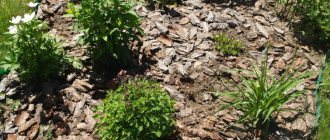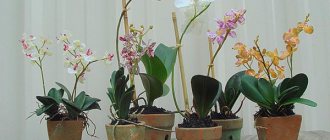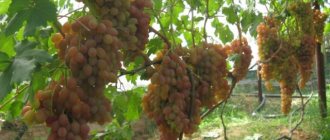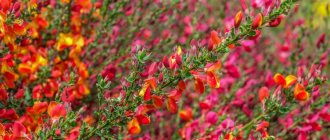Planting young linden seedlings
Linden reproduces well by seeds, stem cuttings and root shoots.
However, this tree is most often propagated by seedlings.
Before planting the linden tree, holes are prepared. For standard seedlings 50-70 cm high, the hole should be 50 cm in diameter and 50 cm deep.
Drainage (10-15 cm) is poured into the bottom of the hole - pebbles, crushed stone, broken brick. This layer is covered with humus diluted with superphosphate (50-60 g).
A seedling is placed in the prepared hole and covered with soil mixture (1 part turf soil, 2 parts each humus and sand). The optimal pH level is 6.5-7.5.
If several seedlings are planted, the distance between the holes should be 3-4 meters; if a linden hedge is formed, the distance is reduced to two meters.
Although linden tolerates replanting normally, when planting seedlings you should be careful with the rhizome. The root collar of the seedling should remain at ground level. If the neck is a little lower, this is not critical for the linden.
After planting and for the first 7-8 days, the seedlings are watered abundantly.
In order for water to accumulate at the location of the linden root system, it is necessary to form a near-trunk hole.
Small-leaved linden tree: planting and care
Small-leaved linden is common in the European part of Russia and Western Siberia. It is characterized by increased frost resistance, shade tolerance and drought resistance. This plant is propagated by seeds, cuttings, grafting and layering.
Despite its shade tolerance, the tree grows and develops better in well-lit areas. When planting in hedges, the distance between seedlings should be at least 2 m, in alleys and groups - at least 4 m. Sod, compost and sand are suitable as a soil mixture. Fertilizing is done in early spring with a solution of mullein, ammonium nitrate and urea. In autumn, nitroammophoska is used.
Tips for caring for linden
Like many crops, linden has its own cultivation techniques, which include watering, fertilizing, pruning and weed removal.
Watering and fertilizing
Linden is very demanding when it comes to watering, especially at the seedling stage.
In adulthood, the tree tolerates short drought quite well. However, in dry times, additional watering is required at the rate of 1 bucket per 1 square meter. m. projections of the linden crown.
In order for the tree to delight with its beauty and lush flowering, you need to know how and what to feed the linden tree in the spring. At the beginning of spring, fertilizer is applied from mullein (1 kg), urea (15 g), ammonium nitrate (25 g), diluted in ten liters of water.
In the fall, it is enough to fertilize the linden tree with 15-20 grams of nitroammophoska.
Removing weeds and loosening the soil
Removing weeds is an important point when caring for a linden tree - their presence inhibits the growth of the tree.
In addition, simultaneously with removing weeds, it is necessary to loosen the soil (to a depth of 10-15 cm) to ensure access of oxygen to the roots. It is optimal to carry out loosening 2-3 times per season.
Mulching
Mulching, like pruning linden, is an important point when growing a tree.
Mulch the tree trunk circle with peat, fallen leaves, wood chips, sawdust or peat compost. The layer height should be 8-12 cm.
Haircut and trimming
The first pruning of seedlings can be done the next year after planting. Pruning is carried out not only to form the linden crown, but also for sanitary purposes.
In winter and early spring, dry branches are pruned.
Linden growing in the form of a hedge is pruned in the first year in early spring and late summer. Subsequently, such a haircut is carried out 4-5 times per season.
Crown care and formation
Only young plants need regular moisture. Adult specimens tolerate drought without problems. They are watered only during the driest period at the rate of 20 liters of water per 1 square meter. m of tree trunk circle.
Loosening the soil under the linden tree is carried out several times a season, while simultaneously removing weeds. Before winter, seedlings are mulched with leaf litter, sawdust, wood chips or peat 10–12 cm thick.
The linden tree is pruned twice a year. Spring sanitary pruning is carried out before the buds open. The tree is carefully inspected and dry, broken and diseased branches are cut off. During autumn formative pruning, crowns growing inward and strongly thickening branches are removed.
At the very first pruning, the branches are shortened by no more than 1/3.
With such careful care, the linden tree will quickly turn into a luxurious, spreading beauty. Rest in its shade will be serene, and the aroma of flowers on a July afternoon will refresh and bring back the best memories.
Planting a linden tree in a summer cottage - video
Vegetative propagation is ideal for linden. Cuttings take place without unnecessary costs, both time and effort. Linden cuttings take root quickly and require minimal care to grow. Linden grows very quickly, so it is worth propagating a large number of cuttings at once.
The soil mixture and cuttings are prepared in advance. Based on the calculation that the linden needs to be planted in the spring, the soil is processed twice a year. The first treatment occurs in the autumn. Before wintering, the soil on the site is dug up, weeds are removed and the plants taking up the space are replanted, then fertilizers are applied, and, as a final touch, the surface of the open soil is leveled with a rake or other garden tool, then covered with polyethylene.
For propagation, it is advisable to use fresh linden cuttings. They are cut early in the morning, while there is no bright sun, which reduces the amount of moisture evaporated from the cuttings, then they are transferred to a warm place and placed in water. Propagation of linden by cuttings is based on two important parameters - the length and width of the cutting. Thin linden cuttings will not take root in open ground or will develop so slowly that they level out gardeners’ expectations.
Each linden cutting must have at least four nodes, which determines the good length of the cutting. The color of the cuttings is greenish, but not soft, which indicates the youth and immaturity of the cuttings, and not woodiness, which characterizes the cutting as old and not suitable for branching. Their approximate length should be from 7 to 12 centimeters. Excessive length does not take root at the expected rate.
Linden cuttings must be treated before planting in open ground. The upper part is cut in a straight line, and the lower part is cut obliquely one and a half centimeters below the level of the kidney. It is necessary to completely clear the lower part of the cutting from the leaves, and you can leave a few green leaves at the top.
Propagation of linden by cuttings can be carried out not only in open ground, but also in greenhouses and greenhouses. In this case, the cuttings take root much faster and are less likely to be susceptible to disease due to stable conditions. The ideal soil mixture for linden propagation is peat and sand in equal quantities, or diluting this mixture with a portion of perlite or any other drainage. Basically, the soil is made light, loose and drained.
The lower part of the linden cutting must be processed before deepening. It is worth using preparations for cuttings and rooting, as well as organic ingredients, such as wood ash, to cover fresh cuts and disinfect the wound caused by the tool. Root the cuttings no deeper than one and a half centimeters, keeping a distance between planting material of 7-10 centimeters. Since many linden cuttings are planted in one cycle, a certain plant spacing is also maintained between the rows - a minimum of 5 centimeters.
Water the linden cuttings after planting with soft water, preferably filtered through a sieve. It is also worth shading and covering the cuttings if they were planted in an open area. In greenhouses it is possible to exclude the last point. Branching of the cuttings will begin at an air temperature of 23-25 degrees and a soil mixture of 26-28 degrees Celsius.
Linden is an amazingly beautiful tree that amazes with its healing properties and delights the sense of smell with a luxurious sweet aroma. It is impossible not to recognize her cute yellow flowers, reminiscent of dragonfly wings. The tree has long been known for its valuable qualities, for which it has been respected and valued for centuries. A linden tree can live for a very long time if it is planted correctly, and for this you need to have an idea of how the tree reproduces (by shoots, cuttings, layering) in autumn and spring. More on this later.
Selection of partners and use of linden in design
Linden is widely used in landscape design. Due to the compactness of the densely-leaved crown, good shade tolerance and undemandingness to watering and soil, various types of linden are planted in city squares, parks, boulevards, forest plantations and summer cottages. Linden also takes root well in an aggressive urban environment - it tolerates dust, smoke, gas pollution and dirt well.
They like to use linden for landscaping due to its decorative value at any time of the year. In spring, delicate greenish leaves bloom on the linden tree, and in summer the dense crown provides reliable shade. Blooming linden is especially good when it is covered with fragrant flowers. In autumn, the foliage takes on a bright yellow hue, which provides warmth in cloudy weather. Against the background of snow, the linden tree amazes with the bizarre outline of its branches.
Linden is grown as a hedge, bosquets, berso and green walls. Such forms are used today to design parks. Linden looks good in single plantings and in groups of trees of various sizes and species. When composing plant compositions, it is necessary to take into account how quickly the linden grows and what role it will play in this: to become the main accent or to highlight the advantages of other plants.
Most often in landscape design the following varieties of linden are used:
- American (black). The homeland of this linden is North America. It grows up to 40 meters, has a wide ovoid crown.
- Fine-grained. Homeland - Europe and Western Siberia. It is distinguished by small compact leaves and a medium-sized ovoid crown.
- Silver. A wild-growing species with original silvery foliage.
- Rubra. Tall tree with a conical crown. It is distinguished by the bright coral color of its young shoots.
- Common linden. Beautiful appearance with a large crown for single and group planting.
The question “what to plant next to the linden tree” can be given a definite answer: almost all shrubs, trees, herbs. Linden looks most harmonious with:
- oak;
- beech;
- maple;
- rowan.
Since linden is a long-lived tree, its plantings can be used without renewal for up to two hundred years.
Description and varieties
Depending on the saturation of the soil and the level of lighting, there are both large plantings of linden trees and small shrubs. Under natural growing conditions, such a crop adapts perfectly to almost any conditions, but most of all it prefers well-moistened and nutritious soils .
Linden tolerates strong winds, seasonal droughts, and severe frosts well. In addition, many gardeners prefer to landscape their garden plots with just such plants, since the linden tree looks extremely attractive and is well resistant to dangerous diseases and pests .
Many species of this crop are considered true long-livers, as the age of some trees reaches 400 years.
There have been recorded cases in history when the age of linden trees crossed the thousand-year mark. The trunks of such trees can grow up to 40 meters in height. Typically, the culture begins to branch at a height of 2 meters above the ground, and by the age of 30 it acquires the status of an adult tree.
In young plantations, the bark is olive or brown in color and has a smooth structure. But mature trees change their color to a darker shade, the bark is covered with deep cracks. The crown is distinguished by its splendor and original oval shape. The root system is massive and well developed, thanks to which it penetrates well into the lower layers of the soil.
Linden leaves are heart-shaped - rounded at the base and pointed towards the end. They are painted in a dark green or matte shade. The crop is widely valued for its honey production. With the arrival of summer, fluffy yellow flowers bloom on the tree, which are collected in small inflorescences that secrete juicy nectar.
In autumn, fruits are formed in their place - small round nuts with seeds. Those who are accustomed to preparing healing infusions from linden know that the flowering period lasts only three weeks. During this period of time, a very pleasant aroma emanates from the tree, which attracts bees.
Extraction of linden honey is considered the most rational, since such a product is highly valued for its taste and medicinal properties. This is due to the fact that linden has long been considered a universal medicinal plant, since its buds and flowers have a universal anti-inflammatory effect.
Timely procurement of such raw materials allows us to produce high-quality compositions and mixtures that effectively eliminate respiratory tract diseases (RTD).
Those who first encountered such a culture are often interested in whether linden is a tree or a shrub? In this case, it is important to understand that everything depends on the growing conditions . The presence of moisture, nutritious soil and good care allow you to grow a large and vibrant tree. If a young seedling is exposed to various negative factors, as well as a constant lack of moisture, then there is a high probability that the gardener will grow an aromatic shrub. Of course, linden trees grow well alone, but most often they can be found in forests, parks and squares.
This culture feels good next to the following trees:
- Pine.
- Ash.
- Oak.
- Spruce.
- Maple.
Before planting a large-leaved plant on your site, you need to study the description of the tree. Linden of this species does not tolerate severe frosts, which is why it grows mainly in the Caucasus and Southern Europe. This species is characterized by longevity, because some trees can grow for five long centuries.
The diameter of the trunks often exceeds 100 cm, and the height reaches 50 meters. Based on the name, the leaves are quite large in size - up to 16 cm. The edges are covered with small jagged edges, but the back side is slightly pubescent.
The crown of the large-leaved linden has an original pyramidal shape , and the inflorescences are small in size. The flowering period occurs in mid-June and lasts 14 days. It is worth noting that fertile, saturated soil is most suitable for this species. Fallen leaves often act as good humus, which saturates the soil with nutrients.
Due to the fact that this tree has excellent decorative qualities, it is often planted in park areas and squares.
On the territory of our country, the Manchurian linden can be found in the dense forests of the Far East and even in the central regions. The culture loves well -moistened soil, tolerates excess shade, as well as high frosts .
The trunks of such lindens have a branched shape and a relatively small height (within 25 meters). The crown is very dense and spreading. As for the leaves, the Manchurian linden has the largest ones - up to 35 cm in length. Powerful inflorescences consist of 12 flowers.
Popularly, the small-leaved linden is often called the heart-shaped linden. The huge advantage of this species is that it tolerates various adverse weather factors (frost, wind, drought). The average lifespan of such a tree reaches 400 years. During active growth, linden trunks grow up to 40 meters in length.
Spreading branches form an original crown, which most closely resembles a tent (the upper shoots always tend upward, the lower ones look down, but the middle ones grow horizontally). The leaves are quite miniature - no more than 5 cm. Their shape is heart-shaped, the apex is slightly pointed.
In early June, the small-leaved linden is covered with fluffy panicles of inflorescences consisting of 8 flowers, but in August, tiny nuts with seeds form in their place. This tree is especially popular throughout Europe, in Kazakhstan and even in Western Siberia.
The silvery appearance of the linden tree has a characteristic difference from all other representatives of the Linden family. Many gardeners are interested in what the leaves of the Silver Linden look like.
They are painted dark green, but the back side is grayish-silver, covered with a small fluff. For this reason, the tree is often called felt linden.
The leaves are of average size - within 9 cm, and on the hottest days their edges curl slightly inward. The tree is highly valued for its decorative qualities . The crown has a beautiful silver-green hue. With the arrival of autumn, the foliage does not turn yellow at all, but gradually withers, remaining on the branches. The flowers are yellow and quite small.
Surprisingly, the young shoots of Silver Linden are also pubescent and only become smooth over time. The bark has a characteristic grayish-brown hue, becoming darker and denser as it matures.
Linden - medicine and valuable honey plant
Due to the presence of biologically active substances, linden is distinguished by beneficial properties.
For medicinal purposes they use:
- Linden blossom.
It has a strong diaphoretic and diuretic effect. Effectively reduces temperature and fights various inflammations. A decoction of linden flowers is indispensable for colds. - Koru.
An excellent remedy for enhancing bile formation. The young bark is used to treat gout, hemorrhoids, and burns. - Wood.
Tar is obtained from it, which is used to effectively treat eczema. - Foliage and buds.
Used as an emollient for abscesses. - Fruit.
Used to treat bleeding. - Charcoal.
It has a unique ability to bind harmful substances in a volume 90 times greater than its own. Used for poisoning, tuberculosis, diarrhea, diseases of the stomach and intestines, as well as in the treatment of open wounds.
Therefore, before pruning the linden tree, it is worth considering all the beneficial qualities of this healing plant.
The procurement of medicinal raw materials for industrial production is carried out from trees whose age reaches 90 years. It is at this time that the maximum amount of raw materials can be obtained from the linden tree.
Linden is also used in cosmetology - as an important component in the manufacture of skin and hair care products.
In addition, linden is an ideal honey tree . Linden honey not only has a great taste and aroma, but also has medicinal properties. It is recommended to grow all linden trees in a garden plot. This way you can increase the productivity of bees and the quality of honey several times.
At first glance, it seems that growing linden is a labor-intensive task. But, having counted all the advantages of this tree, we can come to the conclusion that all the labor costs are worth it. If you know how to choose the right linden seedling, how to plant it and care for it in the future, you will always have at hand a natural healer and a beautiful, rather unpretentious tree that will delight you for a long time and remind your grandchildren and great-grandchildren of you.
Linden: description, useful properties
Linden is a long-liver: in terms of its lifespan it can surpass most trees known to us. So, on average, a linden tree can live about 500 years. It begins to bloom quite late: only in the 20th year of its life (if it grew up in natural conditions). Under artificial conditions, linden produces its first flowers only at the age of 30.
Linden is known to everyone for its honey-bearing properties: from the nectar of one single tree you can get about 16 kg of high-quality, aromatic, surprisingly healthy honey per season.
Linden blossom is actively used in folk medicine: it is dried and stored for several years in small bags made of fabric or paper.
Linden flowers are used in folk medicine
Fragrant linden tea can become not only a pleasant-tasting drink, but also a valuable source of glucose, carotene and other substances beneficial to our body. Linden tea will help get rid of fever, eliminate inflammation in the body, and also have a pronounced diuretic, diaphoretic, and choleretic effect.
In addition to color, linden bark is also actively used for medicinal purposes, which can heal open wounds, treat burns, eliminate dermatological problems, etc.
Attention! Drinking linden tea is contraindicated for people suffering from cardiovascular diseases, since linden has a pronounced ability to accelerate metabolic processes, which puts a high strain on the heart.
Most often, linden grows in groups, but in natural conditions, oppressed by stronger representatives of the flora, it can take on the appearance of a tall shrub. Linden is an unpretentious tree, so its species (and there are a huge number of them) are actively grown for decorative purposes: for landscaping parks, streets, alleys, etc. After all, nothing will decorate a linden tree better than an even row of slender linden trees with a neat crown, which will bloom magnificently and fill the entire area with a thick sweet aroma.
How to plant linden trees in autumn
It is preferable to plant seedlings in late autumn, in late October - early November. At this time of year, physiological processes in almost all plants slow down, which will allow the tree to quickly take root in a new place. The younger the tree is, the more successful the rooting process will be.
It is recommended to purchase planting material from specialized nurseries.
Stages of planting linden seedlings:
- Prepare the planting hole in advance. Its dimensions should be approximately 50x50x50 cm.
- At the bottom of the hole, place a drainage layer 12-15 cm thick. Crushed stone or pebbles can be used as drainage.
- Place soil mixed with 50 g of superphosphate on top of the drainage. Place the seedling on this mixture. The roots in the hole should be spaced evenly and freely.
- Cover the roots of the seedling with soil and water the planting generously.
- Tie the seedling to a pre-prepared stake. This will help protect it from gusts of wind.
When planting, it is necessary to ensure that the root collar of the plant is at ground level and is not buried. When planting several seedlings, the distance between them should be at least 4 m.
How to replant a linden tree
Quite often, if transplanted incorrectly, young linden trees do not take root and die. In order to preserve the plant and prevent damage, you should follow some rules. When digging a seedling out of the ground, it is important not to damage the root system; damaged roots are carefully cut off. Only strong and healthy individuals grown in open, well-lit areas are suitable for transplantation.
Excavated trees must be buried immediately. You cannot leave them in the wind with exposed roots. Planting pits are prepared in advance. The roots in the hole should be free. To tie up the seedlings, you will need stakes; this will protect the young plants from strong wind gusts and help them to become well established in the ground. The trunk is tied to a peg using soft material. Plants are placed in a hole so that the root collar remains on the surface. When adding soil to the roots, you need to immediately compact it from the edges to the center. After this, the tree should be watered generously, even if the transplant is done in wet weather. To ensure that the trunk hole remains moist for as long as possible, it is covered with a layer of dry soil. The soil on the tree trunks must be loosened regularly.
In spring, trees are replanted before buds open. Linden trees are planted in the fall after the end of the growing season. If all the rules are followed, the plant will take root well in its new location.
Transplanting linden trees in autumn: features of the process
Replanting large trees has its advantages. The owner of the plot will not have to wait several years for the tree to grow in all its glory. But it should be borne in mind that the younger the tree being transplanted, the greater the chances of its successful rooting.
As a rule, linden is transplanted in the autumn with a lump of earth on the roots. It is not recommended to leave a seedling with bare roots in the open air, so the planting hole is prepared in advance. It must be filled with a drainage layer and a nutrient soil mixture. To quickly rehabilitate the plant after planting, you can use root system growth stimulants such as Kornevin.
Following the basic recommendations and rules for planting and replanting linden will allow you to decorate the landscape design of your site with beautiful trees. Linden not only looks aesthetically pleasing, but will also give your estate a complete and harmonious image.
The meaning and use of linden
Planting a linden tree on your property is an ideal solution for those who love clean air, a pleasant aroma, and prefer traditional medicine for the treatment of various diseases. After all, its beneficial properties are countless. Almost all parts of this culture are used in the manufacture of medicines. Infusions and decoctions are prepared from the bark, buds, leaves, and flowers.
Of all the variety of honey in our country, linden honey is considered the most healthy. It has antibacterial properties, is used to treat colds, gastrointestinal tract, heals wounds, burns. Dried and crushed linden buds also help with burns.
Ascorbic acid, which is found in almost all parts of the tree, accelerates sweating. Therefore, a decoction of leaves, buds, and flowers can be used to relieve fever. Tea made from flowers is used to treat colds to relieve inflammation.
Craftsmen make dishes and souvenirs from the bark. And in ancient times, bast shoes were woven from bast. Linden wood is white with a pink tint. It is valued in construction and the manufacture of products requiring high strength. For example, musical instruments or furniture. Often houses and bathhouses are built from linden, as it retains heat well and is not affected by rodents.
Application in landscape design
Linden trees are usually planted in alleys, parks, squares, and squares in rows in which the trees are not located very close to each other. Such columns look good if the crown of the plants is formed equally.
As for planting on the site, if it is not very large, it is better to plant one tree, but so that the emphasis is on it. Linden harmonizes perfectly with any other plants and looks good in the same composition with them. Linden is especially combined with various types of conifers. The composition of green shades and fragrant aroma will not leave anyone indifferent. It is in this area of the garden that you can make an excellent recreation area.
Linden: description of the tree and its types
Linden is a very popular plant. The tree is incredibly popular all over the world. There are more than 30 different species in nature. They differ in size and crown shape.
There are linden trees that are over 300 years old.
Main types:
- Caucasian. The tree reaches 40 m tall. The crown is quite round and neat. Young shoots differ from adults in the color of their bark. They have a reddish tint. This species grows in Asia and the Caucasus.
- Manchurian. This type of linden most often grows multi-stemmed. The height of an adult specimen does not exceed 20 m. This is a frost-resistant tree that tolerates sudden drops in temperature well. Linden grows in the Amur region and the Far East.
- Silver or felt. The appearance is distinguished by deciduous plates. In the silver linden they are covered with fine fluff. The tree grows up to 30 m tall. Most often found on Russian lands.
- Small-leaved. This is the most popular species that can be found in all regions of our country. Small-leaved linden is also frost-resistant. It grows up to 30-40 m. It all depends on the planting location.
- Large-leaved (broad-leaved). The tree has a spherical crown. The leaves are small. Their width does not exceed 25 cm. It grows very quickly. Mature trees reach 40 m in height. The broad-leaved species grows on slightly acidic and alkaline soils.
Large-leaved linden can grow 45 cm in height in one year.
Types of linden
The Linden tree genus describes about 45 species. Several varieties are common in Eastern Europe - cordate linden (small-leaved or winter). It is distinguished by the bluish underside of the leaves, on which there are tufts of light brown hairs.
The second variety is large-leaved linden (flat-leaved or summer). It wakes up earlier in the spring and has larger leaves without a bluish coating.
In the Caucasus, Crimea and the central European part of Russia, felt or silver linden is also found. Its heavily pubescent leaves resemble felt to the touch. This variety reaches 35 m in height and has a wide pyramidal crown.
The Caucasian linden is distinguished by its even greater height, spherical spreading crown and reddish-brown shoots.
Manchurian linden is a low tree with good winter hardiness. It is often multi-stemmed. Widely distributed in the south of the Far East.
Linden is easy to propagate by root shoots, stem layering, seeds and seedlings.
Choosing a landing site
Linden is an unpretentious tree. But despite this, it should be taken into account that she loves a lot of light. It is recommended to choose a planting site with drained soil. In this case, the soil may not be fertile. The tree develops well on sandy soils and soils fertilized with humus.
When planting a linden tree, you should take into account that its durability depends on the quality of the procedure performed.
Seedlings take root best in a new location if they were planted on a cool and fairly humid day.
Therefore, the optimal time for planting linden is autumn.
Reproduction by layering
To obtain stem cuttings in the spring before the leaves appear, bend the lower branches to the ground, place them in shallow grooves and dig them in. Cuttings of currants and gooseberries are obtained in approximately the same way. After 1–2 years, the branches will sprout roots and a new plant will appear above the ground. It is cut off from the mother root with a sharp shovel and transplanted to a permanent place.
Propagation of linden by root layering is even easier. Mature plants produce abundant shoots, which are carefully separated from the parent tree and transplanted to a new location.
How to plant a linden tree in the fall
For planting, you can use purchased trees or dig them up near an adult tree. Most of the shoots can be seen in the shelterbelt or forest. They easily tolerate moving over long distances, so the likelihood that seedlings will not take root is minimized.
Stages of planting a tree:
- The first thing to do is dig a hole. The width and depth of the dimple should be within 50 cm.
- Before planting a linden tree on a plot, you need to lay drainage at the bottom of the recess. It could be pebbles, crushed red brick. It is also good to use small pieces of slate. The drainage layer should not exceed 15 cm.
- Sprinkle the top of the drainage with humus and superphosphate. For each seedling it will be enough to use 50 to 60 g of the drug.
- Then pour the prepared substrate on top. It is made from 1 part turf soil and 2 parts sand with humus. It is important to ensure that the soil acidity does not exceed 7.5 pH.
- The distance between seedlings should be from 3 to 4 m. To create a linden hedge, the distance is halved.
When placing a seedling, you must be extremely careful. The root collar of the tree should be above the soil surface. If it is covered with soil, this is not critical for the linden, but in rare cases it can lead to slower growth.
To prevent water from lingering near the trunk, it is necessary to form a near-trunk hole.
Preparation of cuttings and soil mixture
Based on the assumption that seedlings are planted in open ground in the spring, cuttings of the plant and preparation of the site for future plantings should begin in the fall. The soil in the area designated for linden cultivation is well dug up to the depth of a shovel, fertilizers are added to it - preferably humus or compost plus wood ash, and finally the surface is leveled using a garden rake and covered with polyethylene for the entire winter season.
It is worth saying that this tree can be successfully propagated in other ways: by layering, using root shoots, and seeds. But propagation of linden by cuttings, although a rather labor-intensive method, is used by gardeners quite often.
Cuttings are cut from an adult tree in the early morning or in cloudy rainy weather - this significantly reduces the percentage of moisture evaporated from the shoot. The upper cut is made above the bud at a right angle, in order to also minimize moisture loss by reducing the evaporating surface. The lower cut is made obliquely, 1 centimeter below the kidney.
The main parameters for choosing branches for cuttings are diameter and length. Planting material from a thin shoot will develop very slowly, and given that the linden tree already blooms only a couple of decades after planting, this is unacceptable. The optimal length of the cutting is determined by the number of nodes, of which there must be at least four, this is 8-15 centimeters. For cuttings, only green and flexible shoots with fully formed leaves are used.
Each cutting is placed in a separate container with water, in which a drug such as Kornevin or Epin is pre-dissolved - these products are designed to stimulate root formation and help plants during the period of adaptation to new conditions. After half an hour, the water from the container should be drained and replaced with fresh water - in it the shoots will wait until the root shoots appear.
It is important to ensure that in the room where the cuttings are located while waiting for the development of the root system to begin, a constant air temperature is maintained at least +25 degrees.
Caring for linden trees on the site
The tree will be beautiful and healthy if you follow the minimum care rules. It is enough to water, fertilize, remove weeds, and trim branches in a timely manner.
Irrigation rules
Only planted trees need abundant watering. Use water at room temperature. It is better not to irrigate seedlings with cold liquid, as this can slow down their growth.
Top dressing
The first fertilizer is applied in early spring. To do this, make a solution from mullein (1 kg), urea (15 g), and saltpeter (25 g). Mix all components thoroughly and add 10 liters of clean water. In the autumn, it is recommended to apply nitroammophoska. For one tree, about 20 g of the drug will be enough.
Mulching
This is an important procedure when growing linden. The tree trunk circle is covered with mulch after each weeding. To do this, you can use peat, dry tree leaves, wood shavings or peat compost. The mulch thickness should be within 12 cm.
Trimming
Linden pruning is carried out in spring and autumn. The first procedure can be carried out the next day after planting. In spring, remove all damaged and dry branches. Sanitary pruning will help maintain the attractive appearance of the tree and protect it from diseases.
In order to form a beautiful green ball without a stem from a linden tree, radical pruning is carried out. In this case, all the branches, and sometimes even the trunk, are cut down, leaving a stump.
It is also recommended to periodically thin out the crown. If this is not done, the branches will begin to dry out. Improper application of fertilizer leads to excessive density. Also, the number of shoots on a linden tree increases if it grows in open areas.
Pests
Linden, like all other trees, is attacked by various insects. Most often, holey spots are observed on the leaves. You can get rid of it by spraying the trunk and branches with Bordeaux mixture. To combat white rot, products containing more copper are used.
In addition, aphids, cutworms, mites, bark beetles, and leaf rollers may appear on the tree. These insects are controlled with insecticides. Trees are also attacked by birds and rodents that like to feed on bark.
Diseases and pests
Experts say that linden is well resistant to dangerous fungi and insects, but in some cases it can be affected by the following diseases:
- White rot. To effectively eliminate this problem, you must use those preparations that contain copper (for example: copper sulfate).
- Black or holey spotting. The gardener must remove all damaged leaves and fruits as the main source of re-infection. For wood processing, it is best to use Bordeaux mixture (1%).
In addition to diseases, linden can be attacked by pests:
- Pyramid scoop.
- Goldentails.
- Leafrollers.
- Klopov.
- Moths.
- Silkworms.
- Hawkmoth lilac.
- Pipe bug.
- Gall mite.
- Bark beetles.
- Scale insects.
The main signs of the presence of pests are that various inclusions, holes, insect marks and even cobwebs appear on the foliage of the tree. In addition, the external characteristics of the tree deteriorate significantly. To effectively eliminate such insects, high-quality insecticides with a wide range of applications must be used. It is also worth considering that even rodents and birds can harm the linden tree. In this case, you need to use special traps, which can be purchased at any specialized store.
Linden propagation
To plant a tree, you do not have to buy expensive planting material in the store. You can grow a seedling at home.
Reproduction methods:
- stem layering;
- root cuttings;
- seeds;
- cuttings.
Propagating linden by seeds will require a lot of time and effort. In order for the grains to germinate and quickly increase in growth, they need to be stratified. Sow linden to a depth of 2 to 3 cm. In this case, the soil should be nutritious and well-permeable to air. When the seedlings reach 15 cm, they can be planted in open ground.
Before planting a linden tree with cuttings, you need to prepare planting material. Branches should only be cut from mature trees. Their length should be from 8 to 15 cm. The upper cut is made at a right angle, and the lower one - oblique.
As you can see, planting and caring for linden does not require any special skills. The tree will develop well if you choose the right site and water it in a timely manner. Also, don't forget about pruning. This is a procedure with which you can make a linden tree a real decoration of the garden.
How to grow linden from seeds
Propagation by seeds is the longest growing method. From the moment the seedlings transform into a young tree, at least 10 years will pass.
For good germination, linden seeds must be stratified. They are placed in a container with a damp substrate and placed in a cool, dark place for 5–6 months, periodically moistening.
In spring, stratified seeds are sown in open ground. The seedlings are protected from wind and heavy rain and thinned out. At the beginning of summer, seedlings are fed with fertilizers containing nitrogen; in the second half of summer they switch to phosphorus-potassium mixtures.
For the winter, young sprouts need shelter. The following year, the plants are planted in a permanent place, which should preferably be fenced.
Reproduction
Linden is propagated by growing seedlings from seeds, digging root cuttings, and cuttings created from low-lying branches. It may take 10 years before a young flowering tree is obtained.
In early spring, a part of the lower branch is buried, securing it to the ground. The site is marked and watered, especially during summer dry periods. Rooting continues for more than one season. The seedling will be ready for planting in 2-3 years.
It is easier to propagate linden this way because it produces abundant root shoots. A seedling with a thick lobe is selected and moved to a new area.
Growing linden with seeds is a long and rather complicated process. But as a result, you can get more than a dozen seedlings. Under natural conditions, linden seeds do not germinate next spring, but a year later. Therefore, to germinate, they need to be stratified for a long time - up to six months. To do this, prepare a container with wet sawdust, sand or a sand-peat mixture (in a 1:1 ratio). The seeds are deepened by 2-3 cm, the container is placed in a cold and dark place, preferably with a temperature that remains at zero. The mixture is watered moderately all the time so that the seeds do not dry out.
In the spring, the seeds are taken out and sown in a plot in the garden. If there is a threat of return frosts, the seedlings must be covered, otherwise they may die. Young stickies are sensitive to moisture. They are watered regularly and the soil is kept free of weeds. In good conditions, by autumn the seedlings grow to 15-50 cm. A full-fledged seedling is obtained after 2 years. Different species have different growth vigor. Small seedlings are transplanted only in the spring; they do not tolerate autumn transplantation well.
If seedlings are grown in containers, the substrate is prepared from 1 part of turf or garden soil, and also 2 parts of humus and sand. Humus is sometimes replaced with compost.
Characteristic
Small-leaved linden is an unpretentious, winter-hardy, shade-tolerant and drought-resistant tree. Tolerates 40-degree frosts. It likes to grow in spacious sunny areas; the crown in such a planting becomes especially luxurious. Large trees grow on fertile, moderately moist soils with good natural drainage. In its distribution area, small-leaved linden is found on different types of soil. The best soil for it is sandy, enriched with humus. The tree will not grow in areas where groundwater is close to it.
The period of development of linden is very extended. Young seedlings rise slowly. Only after 7–10 years of age do trees grow more intensively and exceed 2–3 m. A tall, spreading small-leaved linden tree is formed only by the age of 40. Due to their strong roots, mature trees do not need watering. Water young plants during prolonged periods of drought. Caring for seedlings includes regular watering.
Linden was widely used and continues to be used in landscaping. But a durable tree cannot tolerate concentrations of pollutants - in the conditions of the streets of industrial cities it lives only up to 60-80 years. In city parks, linden plantings last twice as long.
Beekeepers try to plant large groups of linden trees, if possible, on the site. Thanks to linden nectar, the productivity of bee colonies increases and the quality of honey improves.
Application in landscape design
Linden trees are often planted in parks, as well as in spacious garden plots. Thanks to its silky, spreading, but neatly formed crown, the tree is very decorative. The crown forms independently, but the tree easily tolerates pruning and holds the silhouette created by the garden designer for a long time. This powerful plant looks spectacular in different garden design options.
- Lipa is a bright soloist, located no closer than 8-10 m from a residential building.
- Creates a dense hedge, almost a green wall, which can be trimmed as desired. Seedlings for the hedge are placed every 2 m.
- Romantic alleys that will become more and more charming as you grow older. The distance between seedlings is at least 4 m.
- Picturesque groves of several trees.
When planting a linden tree, you need to remember that in 10-15 years it will spread its branches widely and occupy a large area. Dense foliage does not allow you to choose a wide range of ground covers.
How to plant a beautiful linden tree and what care does it need?
Mighty linden trees have a beautiful curly crown. In summer it turns into a fragrant, buzzing hive. If the plot is spacious, its owners can plan in advance how and where to plant the linden tree. Several trees will make a great grouping. The linden tree will become tall and lush in a few decades. The young tree is distinguished by its plasticity; the crown is given the appearance of choice. Linden trees at any age are attractive due to the cozy shadow created by the picturesque foliage.
The broad-leaved tree formed in a temperate climate millions of years ago. Most common in Europe and Asia, there are more than 30 species. It grows in wild and cultivated forms. Different types of linden bloom from spring to mid-summer. The tree is a long-liver; there are specimens that grow for over 500 years. There are large linden plantations on the site of old landowners' estates, which are more than 200 years old.
The trunk grows up to 40 m, the crown is rounded and very spreading. Dark red young shoots look picturesque. Found in the Caucasus and northwest Asia.
The tree often grows with many trunks, rising up to 20 m. The frost-resistant species is common in the Far East and the Amur region.
This species is also called tomentose linden. The leaves have a delicate fluff on top and a dense fluff on the bottom. A tree with a wide pyramidal crown, tall, reaches 30 m. It is found in the forests of the middle climatic zone of Russia.
In our country this is the most common type. Usually, when people talk about linden, they mean this type of linden tree.
- Linden large-leaved, or broad-leaved
Very similar to small-leaved. The surface of the leaf blade is wider, up to 12 cm. A tree with a tent-shaped crown, a width from 18 to 25 m. It grows faster than a small-leaved tree, reaching 40 m. Over the course of a year, a seedling grows by 45 cm, and the crown spreads out to 35 cm. It is demanding on soils, develops better on alkaline or slightly acidic soils. Distributed in Western Europe in regions with mild winters.
When buying seedlings of Manchurian and broad-leaved linden, choose those grafted onto small-leaved linden. They develop faster and bloom from 5-6 years.











